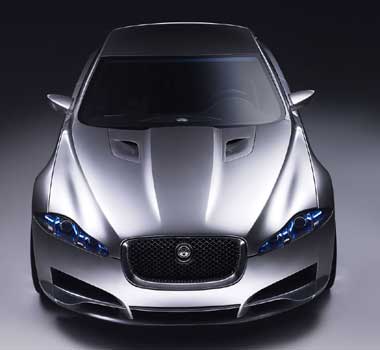Jaguar's new design direction
C-XF designers have broken with the past to bring drivers the future of Jag sports saloons, writes Sean O'Grady

Beguiling, isn't it? This is the Jaguar C-XF, a concept car that should give you more than a clue as to how the next new Jag saloon will look. As the company's press release puts it, the styling "provides very clear direction as to the design and intent of the car that will replace the S-Type ... it showcases a new direction for Jaguar sports saloons and by implication the future of the brand".
If so, then that is very good news, and proof that the company's head designer, Ian Callum, can come up with starkly modern looks that are just as graceful as the more retro-inspired shapes of the past. Jaguar desperately needs a hit in this sector of the market: at last they look like outshining the German brands.
What's new? Well, most refreshing of all is that break with the past. When a brand gets locked into a styling idiom, a "classic" look can be a good thing and a bad thing. Good, because the look is instantly recognisable, and the visual cues mean buyers know exactly what they're getting.
Thus, the Volkswagen Golf, for example, has gone through five iterations, building on the same styling themes first devised by Giugiaro 30 years ago. The new "New Mini" looks just like the last one. Jaguars, too, have tended to follow the path set by such classics as the E-Type, the Mark II and the first XJ saloon of 1968.
Five years ago, Jaguar was told to build a "baby" saloon to take on the ubiquitous BMW 3 Series. BMW employed Chris Bangle to start to change its design language, with success. But because a small saloon was such a departure for Jaguar, it had to look like a Jaguar car immediately. Hence the scaled-down XJ-styling. Classic and handsome, but not sporty or aggressive enough to attract new buyers.
The X-Type was supposed to spawn a whole family of variants - coupés, convertibles maybe - but only the estate version made it into production. It never really laid a glove on the BMW 3 Series, despite its dynamic abilities. Traditionalists decried its links with the parent Ford's Mondeo model; the young and thrusting left it to one side. Much the same could be said of the S-Type, with its 1960s throwback styling and Lincoln underpinnings. They looked like thoroughbreds, but they weren't. (It looks like the new XF saloon will carry over the S-Type's chassis, by the way.)
So that's the bad thing about retro styling; you get stuck in a rut, and people wonder what's the point of buying the new car when it looks just like the old one. In Jaguar's case, this compounded the "old man's car" image. Time for something radical. Time then for Callum, the man behind the Aston Martin DB7 and DB9, and the XK coupé to show his class.
So this is what we've got. A car that oozes its heritage but is still fresh and modern. It picks up a little on the old XJ's grille and bonnet lines, and the badging is very trad too; but the rest is gracefully modern. In the cabin, the walnut and leather has been ditched for more contemporary materials and an up-to-date look with less clutter. Jaguar by feng shui, you might say. Externally there are harder, straighter lines than we've been accustomed to, lending a purposeful look, as buyers want. Like the luscious Mercedes-Benz CLS, it has the air of a four-door coupé.
Like the Jaguar XJ of 1968 and the XJ-S of 1975, this Jaguar concept marks a break with tradition. How could Ford even think of selling the brand on the verge of such a breakthrough?
Subscribe to Independent Premium to bookmark this article
Want to bookmark your favourite articles and stories to read or reference later? Start your Independent Premium subscription today.

Join our commenting forum
Join thought-provoking conversations, follow other Independent readers and see their replies